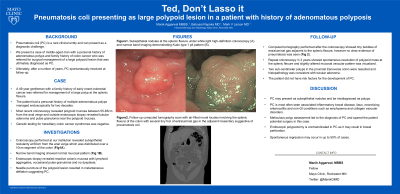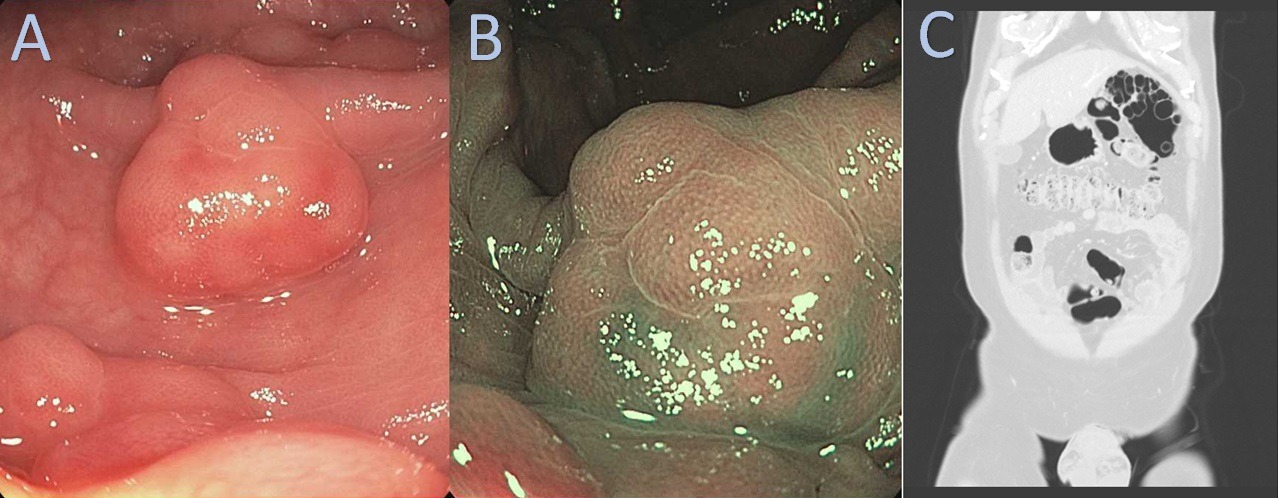Tuesday Poster Session
Category: General Endoscopy
P3436 - Ted, Don’t Lasso It: Pneumatosis Coli Presenting as Large Polypoid Lesion in a Patient with History of Adenomatous Polyposis
Tuesday, October 24, 2023
10:30 AM - 4:00 PM PT
Location: Exhibit Hall

- MA
Manik Aggarwal, MBBS
Mayo Clinic
Rochester, MN
Presenting Author(s)
Manik Aggarwal, MBBS, Babusai Rapaka, MD, Mark V. Larson, MD
Mayo Clinic, Rochester, MN
Introduction: Pneumatosis coli (PC) is a rare clinical entity and can present as a diagnostic challenge. We present a case of middle-aged man with a personal history of adenomatous polyps and family history of colon cancer who was referred for surgical management of a large polypoid lesion that was ultimately diagnosed as PC. Ultimately, after a number of years, PC spontaneously resolved at follow-up.
Case Description/Methods: A 49-year gentleman with a family history of early onset colorectal cancer was referred for management of a large polypoid lesion, thought to be neoplastic, located at the splenic flexure. The patient had a personal history of multiple adenomatous polyps managed endoscopically for two decades. Most recent colonoscopy revealed a segmental area with numerous large polypoid lesions. Genetic testing for hereditary colon cancer syndromes was negative. The patient did not have risk factors for the development of PC.
Colonoscopy performed at our institution revealed extensive subepithelial nodularity from 55-65 cm from the anal verge. (Fig1A). Narrow band imaging showed normal mucosal pattern (Fig 1B). Endoscopic biopsy revealed reactive colonic mucosa with lymphoid aggregates, occasional pulse granuloma and no dysplasia. Needle puncture of multiple polypoid lesions resulted in instantaneous deflation suggesting PC. Computed tomography performed after the colonoscopy showed tiny bubbles of extraluminal gas adjacent to the splenic flexure. Follow up colonoscopy and imaging one year later again demonstrated clear evidence of PC (Fig 1C). However, repeat colonoscopy in 3 years showed spontaneous resolution of the polypoid lesions, leaving only a slightly altered mucosal vascular pattern in that location. Two sub-centimeter polyps in the proximal transverse colon were resected and histopathology was consistent with tubular adenoma.
Discussion: PC may present as subepithelial nodules and be misdiagnosed as polyps. PC is most often seen associated inflammatory bowel disease, ileus, necrotizing enterocolitis and non-GI conditions such as emphysema and collagen vascular disorders. Meticulous polyp assessment led to the diagnosis of PC and spared the patient potential surgery in this case. Endoscopic polypectomy is contraindicated in PC as it may result in bowel perforation. Spontaneous regression may occur in up to 50% of cases.

Disclosures:
Manik Aggarwal, MBBS, Babusai Rapaka, MD, Mark V. Larson, MD. P3436 - Ted, Don’t Lasso It: Pneumatosis Coli Presenting as Large Polypoid Lesion in a Patient with History of Adenomatous Polyposis, ACG 2023 Annual Scientific Meeting Abstracts. Vancouver, BC, Canada: American College of Gastroenterology.
Mayo Clinic, Rochester, MN
Introduction: Pneumatosis coli (PC) is a rare clinical entity and can present as a diagnostic challenge. We present a case of middle-aged man with a personal history of adenomatous polyps and family history of colon cancer who was referred for surgical management of a large polypoid lesion that was ultimately diagnosed as PC. Ultimately, after a number of years, PC spontaneously resolved at follow-up.
Case Description/Methods: A 49-year gentleman with a family history of early onset colorectal cancer was referred for management of a large polypoid lesion, thought to be neoplastic, located at the splenic flexure. The patient had a personal history of multiple adenomatous polyps managed endoscopically for two decades. Most recent colonoscopy revealed a segmental area with numerous large polypoid lesions. Genetic testing for hereditary colon cancer syndromes was negative. The patient did not have risk factors for the development of PC.
Colonoscopy performed at our institution revealed extensive subepithelial nodularity from 55-65 cm from the anal verge. (Fig1A). Narrow band imaging showed normal mucosal pattern (Fig 1B). Endoscopic biopsy revealed reactive colonic mucosa with lymphoid aggregates, occasional pulse granuloma and no dysplasia. Needle puncture of multiple polypoid lesions resulted in instantaneous deflation suggesting PC. Computed tomography performed after the colonoscopy showed tiny bubbles of extraluminal gas adjacent to the splenic flexure. Follow up colonoscopy and imaging one year later again demonstrated clear evidence of PC (Fig 1C). However, repeat colonoscopy in 3 years showed spontaneous resolution of the polypoid lesions, leaving only a slightly altered mucosal vascular pattern in that location. Two sub-centimeter polyps in the proximal transverse colon were resected and histopathology was consistent with tubular adenoma.
Discussion: PC may present as subepithelial nodules and be misdiagnosed as polyps. PC is most often seen associated inflammatory bowel disease, ileus, necrotizing enterocolitis and non-GI conditions such as emphysema and collagen vascular disorders. Meticulous polyp assessment led to the diagnosis of PC and spared the patient potential surgery in this case. Endoscopic polypectomy is contraindicated in PC as it may result in bowel perforation. Spontaneous regression may occur in up to 50% of cases.

Figure: Subepithelial nodules at the splenic flexure under white light high definition colonoscopy (A) and narrow band imaging demonstrating Kudo type 1 pit pattern (B). Follow up computed tomography scan with air-filled mural locules involving the splenic flexure of the colon with several tiny foci of extraluminal gas in the adjacent mesentery suggestive of pneumatosis coli.
Disclosures:
Manik Aggarwal indicated no relevant financial relationships.
Babusai Rapaka indicated no relevant financial relationships.
Mark V. Larson indicated no relevant financial relationships.
Manik Aggarwal, MBBS, Babusai Rapaka, MD, Mark V. Larson, MD. P3436 - Ted, Don’t Lasso It: Pneumatosis Coli Presenting as Large Polypoid Lesion in a Patient with History of Adenomatous Polyposis, ACG 2023 Annual Scientific Meeting Abstracts. Vancouver, BC, Canada: American College of Gastroenterology.
